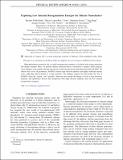Exploring Low Internal Reorganization Energies for Silicene Nanoclusters
Author(s)
Lopez-Rios, Hector; Mendoza-Cortes, Jose-L.; Fomine, Serguei; Pablo Pedro, Ricardo; Kong, Jing; Van Voorhis, Troy; Dresselhaus, Mildred; ... Show more Show less
DownloadPhysRevApplied.9.054012.pdf (1.837Mb)
PUBLISHER_POLICY
Publisher Policy
Article is made available in accordance with the publisher's policy and may be subject to US copyright law. Please refer to the publisher's site for terms of use.
Terms of use
Metadata
Show full item recordAbstract
This paper is a contribution to the Physical Review Applied collection in memory of Mildred S. Dresselhaus.
High-performance materials rely on small reorganization energies to facilitate both charge separation and charge transport. Here, we perform density-functional-theory calculations to predict small reorganization energies of rectangular silicene nanoclusters with hydrogen-passivated edges denoted by H-SiNC. We observe that across all geometries, H-SiNCs feature large electron affinities and highly stabilized anionic states, indicating their potential as n-type materials. Our findings suggest that fine-tuning the size of H-SiNCs along the “zigzag” and “armchair” directions may permit the design of novel n-type electronic materials and spintronics devices that incorporate both high electron affinities and very low internal reorganization energies.
Date issued
2018-05Department
Massachusetts Institute of Technology. Department of Chemistry; Massachusetts Institute of Technology. Department of Electrical Engineering and Computer Science; Massachusetts Institute of Technology. Department of PhysicsJournal
Physical Review Applied
Publisher
American Physical Society
Citation
Pablo-Pedro, Ricardo et al. "Exploring Low Internal Reorganization Energies for Silicene Nanoclusters." Physical Review Applied 9, 5 (May 2018): 054012 © 2018 American Physical Society
Version: Final published version
ISSN
2331-7019